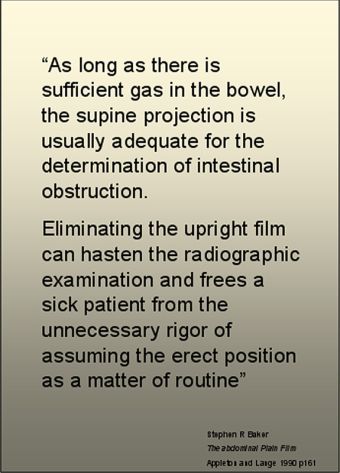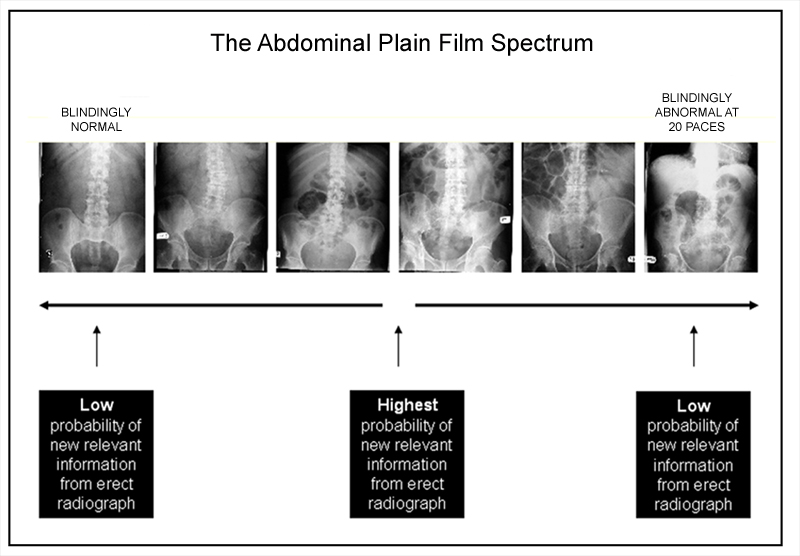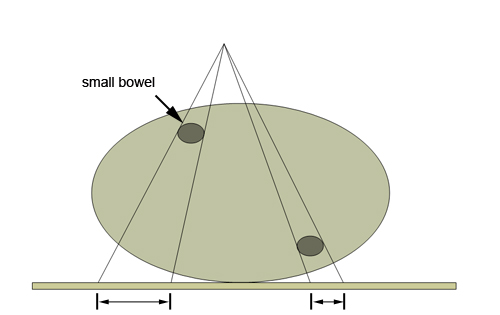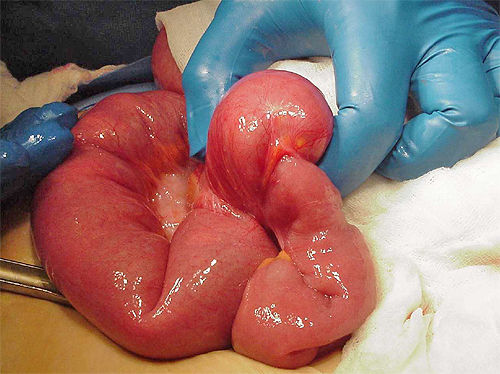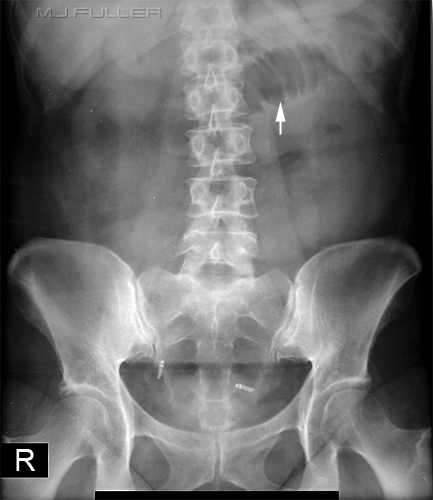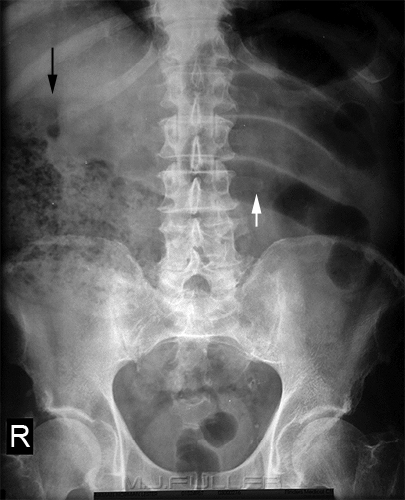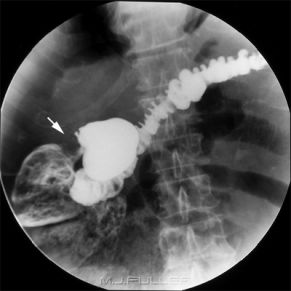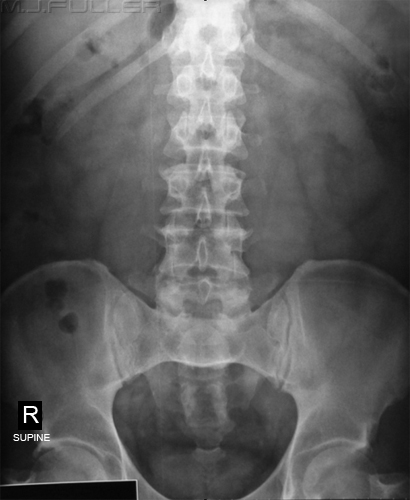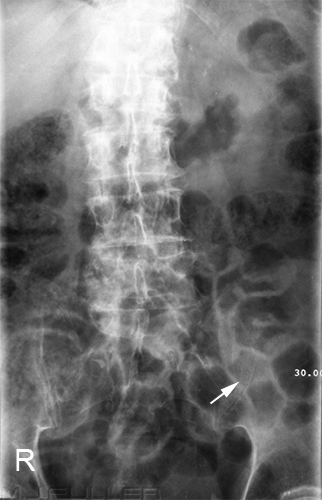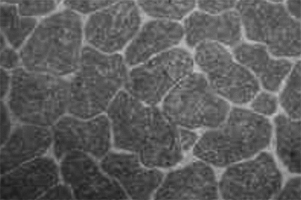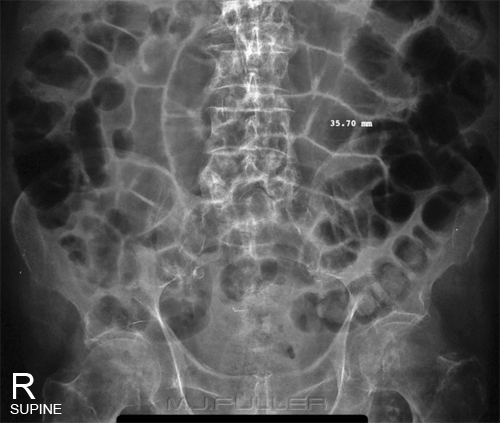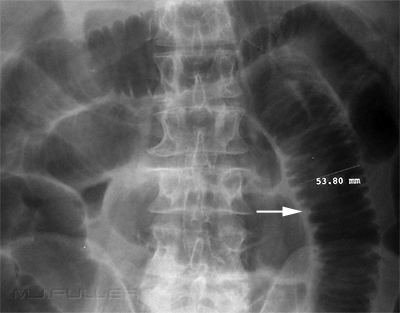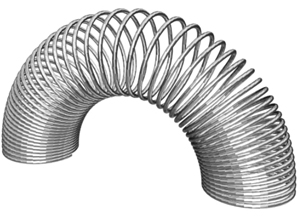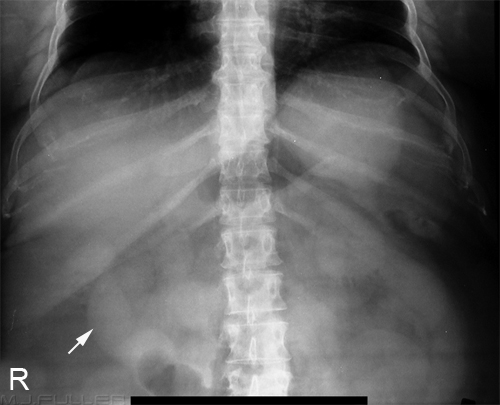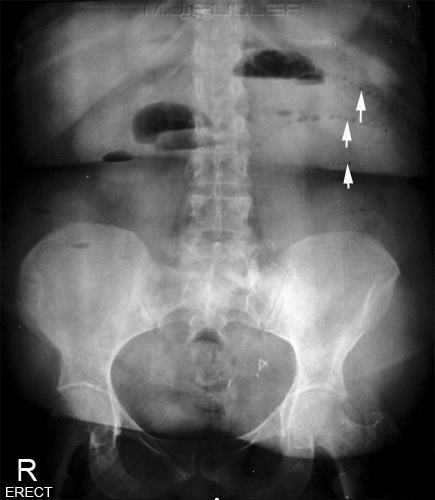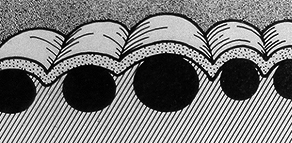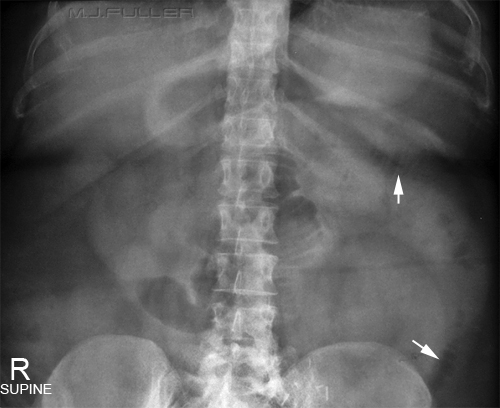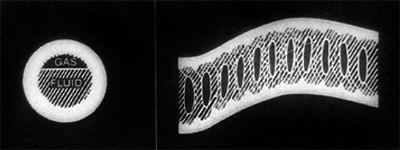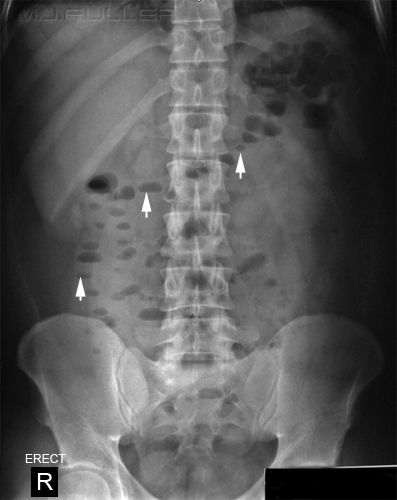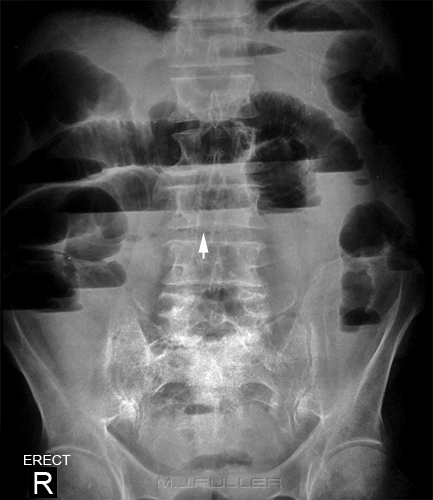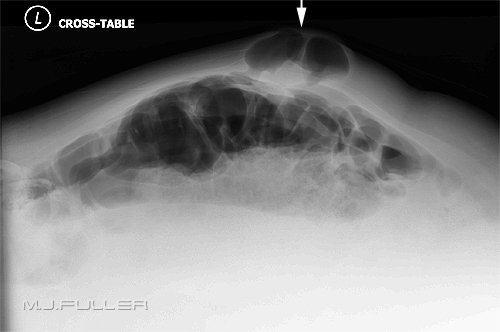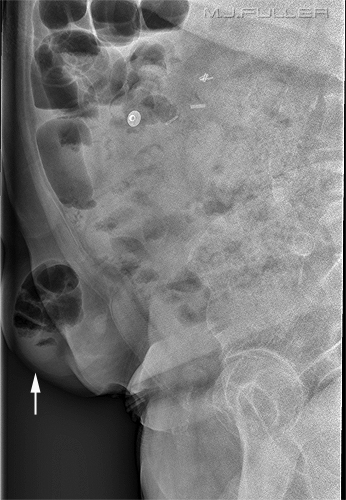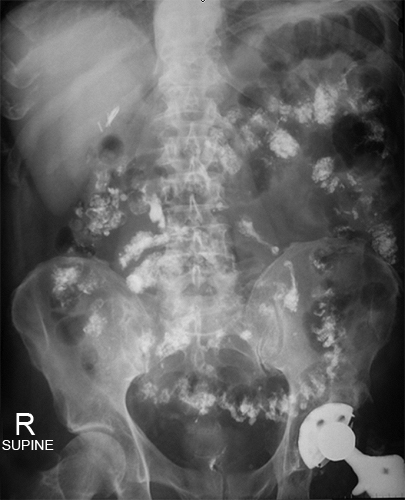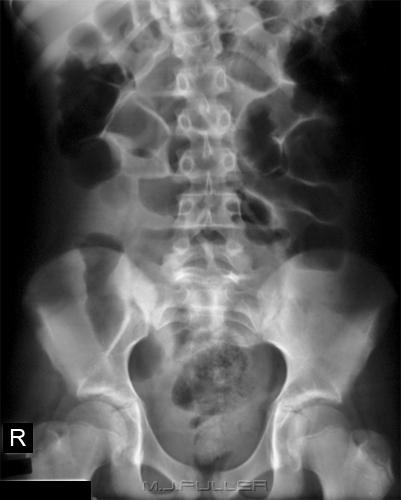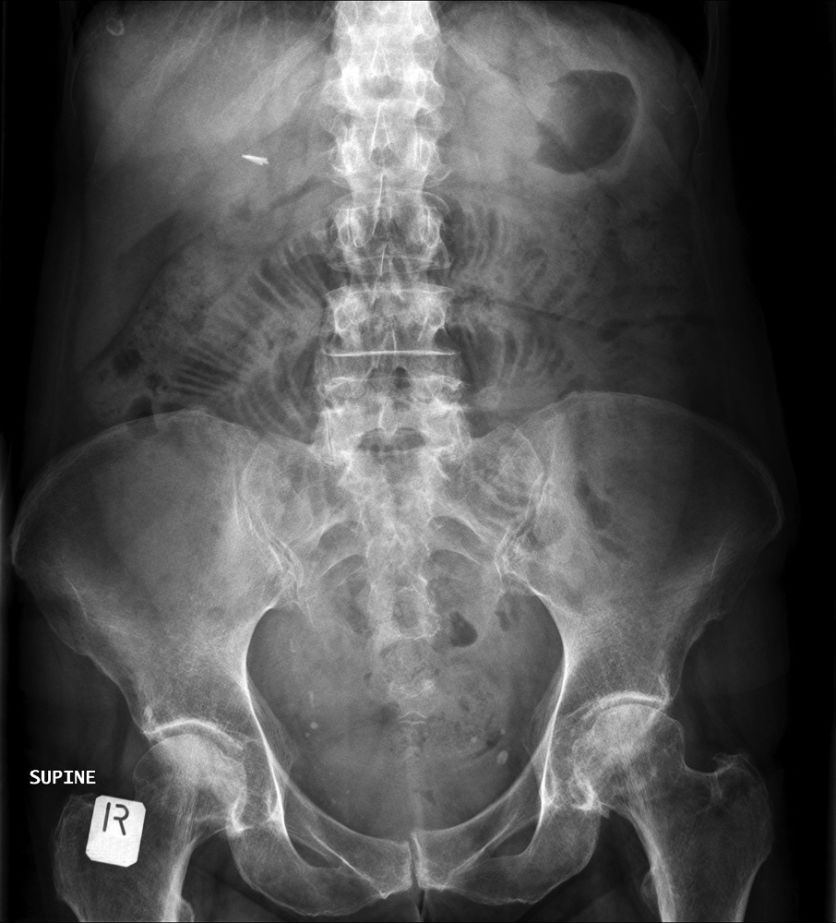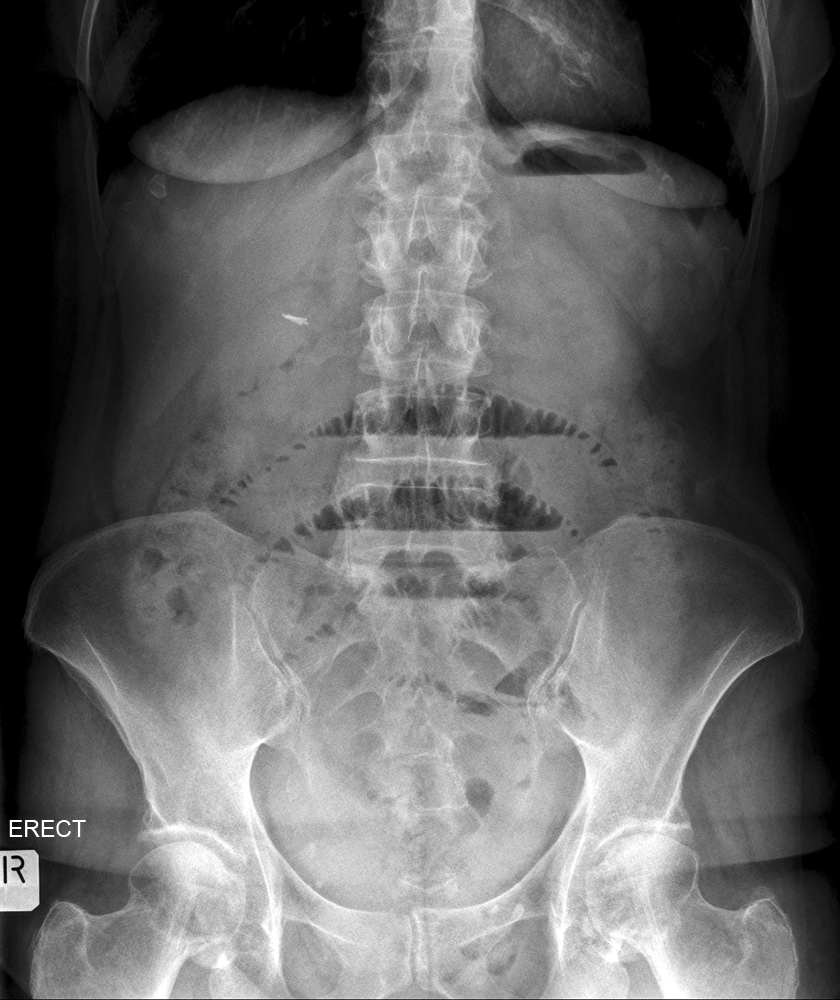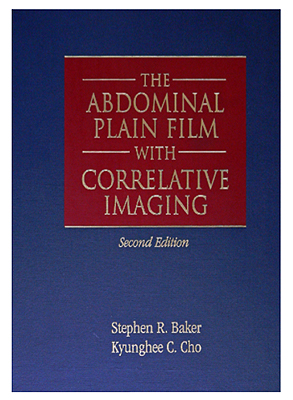Small Bowel Obstruction
Small bowel obstruction (SBO) is a common abdominal pathology. This page examines radiographic techniques and pathological appearances of plain film small bowel obstruction. Before reading this page, it would be advisable to read the page on terminology and the page on differentiating small and large bowel appearances on plain film.
Definition of Small Bowel Obstruction (SBO)
Radiographic TechniqueSmall bowel obstruction refers to any condition where there lumen of the small bowel is obstructed. The obstruction may be intrinsic (as with intussusception) or extrinsic (as with abdominal adhesions). A small bowel diameter on plain film greater than 30mm is considered dilated.
Appropriate views for an acute small bowel obstruction should start with a supine abdominal plain film X-ray. It could be argued that all acute abdominal imaging should include an erect AP/PA chest view to demonstrate pneumoperitoneum. There is also the possibility that the abdominal symptoms are misleading.
The erect abdominal plain film should be undertaken to clarify the appearances on the supine image, or where there is a reasonable expectation of additional relevant findings (see discussion below and here). The erect abdominal plain film should not be performed in isolation under normal circumstances.
Where there are equivocal findings on the supine image, a repeat supine abdominal plain film image can be very useful. It should be remembered that an abdominal image provides a snapshot of the bowel at a particular point in time. If there is an equivocal or suspect appearance, a repeat view taken as little as 10 minutes later will often confirm an appearance as being pathological rather than a normal transient chance appearance.
A rarely utilised projection in the acute setting is the prone abdominal view. The advantage of the abdominal plain film with the patient in the prone position is that the dependent and non-dependent parts of the bowel are reversed. The disadvantage is that the patient is unlikely to find the position comfortable.
The left lateral decubitus view is a suitable alternative to the erect abdominal view. A right lateral decubitus or supine cross table lateral decubitus should also be considered in appropriate circumstances.
A tangential view of external hernias can reveal incarcerated small bowel (see examples on this page).
The Erect Abdominal Film in Small Bowel Obstruction
The difference between the supine abdominal plain film and the erect abdominal plain film has plenty to do with gravity and not much else. Not to put too fine a point on it, the AP supine abdominal plain film and the erect AP abdominal plain film are projections of the same anatomy and are even under the same gravitational forces. The difference lies in the fact that a contained air/fluid filled structure will have an interface that is imaged en face in the supine projection and in profile in the erect projection.
There are, of course, other more subtle benefits of the erect plain film as follows
- potential to include all of the upper abdomen (centre slightly more superiorly)
- in a gasless obstruction, loops of fluid filled small bowel can be seen to drop under the effect of gravity
- possibility of demonstrating a string-of-pearls sign
- others I'm sure
The PosterI have placed a poster on the wall of the X-ray viewing area in the Emergency Department as shown below
This is a quotation from the abdominal plain film bible by Stephen R. Baker. His book titled The Abdominal Plain Film is out of print but second hand copies are available from Amazon. In my opinion it's well worth the money. We have a copy in our Radiology library but it is continuously out on loan.
Abdominal plain films are not necessarily either normal or abnormal; this is not a dichotomy- it's a continuum. If you are one of those people that likes to categorise things, you could think of them as being;
normal -------------> probably normal ----------> suspect ------->probably abnormal-----> definitely abnormal
The Role of CT
CT is the gold standard of diagnostic imaging in patients with acute abdominal symptoms. Whilst a plain abdominal film can suggest a diagnosis of small bowel obstruction, CT is more likely to reveal the cause and site of obstruction.
Clinical Presentation of SBO
abdominal pain
squealing bowel sounds (early obstruction)
no bowel sounds (bowel wall muscular exhaustion)
rapid onset of nausea and vomiting
belching
abdominal rigidity
abdominal swelling
Causes of Small Bowel Obstruction
Treatment of SBO
- Adhesions
- Neoplasms
- Hernias-external, internal
- Crohns
- Other
The most common cause of small bowel obstruction in the western world is from adhesions secondary to abdominal surgery. An adhesion is an abnormal band of tissue which can indent/deform the small bowel causing obstruction.
It is useful for the radiographer to establish with the patient whether they have had abdominal surgery in the past - this may assist in interpretation of the plain film abdominal image. Furthermore, it is helpful to ask the patient if they have had multiple episodes of SBO from adhesions in the past.
Consider any abdominal wall asymmetry as a potential hernia or other pathology. Radiographers have demonstrated umbilical and incisional hernias only because they have noticed the patient had an unusual abdominal wall asymmetry.
(Some texts will show hernias as the second most common cause of SBO)
The treatment of SBO will vary with the circumstances of individual cases. Insertion of a naso-gastric tube into the patient's stomach is a common treatment. Some patients are treated conservatively to see if the SBO will resolve spontaneously. Gastrografin has also been used as a therapeutic agent in SBO. Surgical intervention is sometimes required.
Diagnostic Accuracy
The abdominal plain film is a blunt diagnostic tool. It has been likened to taking a patient's temperature- an abnormal plain film appearance suggests that there is abdominal pathology present much the same as a high temperature suggests that a patient has an infection.
The 3,6,9 Rule
There is a good report on a study investigating the accuracy of the abdominal film in the diagnosis of SBO here <a class="external" href="http://www.ajronline.org/cgi/reprint/188/3/W233" rel="nofollow" target="_blank">http://www.ajronline.org/cgi/reprint/188/3/W233</a>
The maximum diameter of the bowel is shown below
Maximum Normal Diameter small bowel 30mm large bowel 50-60mm caecum 90mm
The 3,6,9 rule is a very useful guide to determining when the bowel is dilated. It can also be useful in distinguishing between small and large bowel. For example, if the small bowel measures 90mm in diameter it is probably not small bowel.
Geometric Magnification Issues
The 3,6,9 rule is for uncorrected measurements. The error associated with an uncorrected measurement is usually not a problem. Where it can be a problem is in morbidly obese patients where the small bowel is situated close to the LBD/focal spot.
If you perform erect abdominal images PA rather than AP you may identifying small bowel affected by geometric enlargement demonstrated on the supine image
Small Bowel Appearances Indicating SBO
- small bowel dilated over 30mm
- multiple air/fluid levels in small bowel
- stretch/slit sign
- string of pearls sign
- coiled spring sign
The important finding in SBO is a change in calibre of the small bowel. If the SBO is sufficiently obstructed, the small bowel proximal to the obstruction will dilate. Small bowel with a diameter greater than 30mm is considered to be dilated. Small bowel can dilate up to around 50mm. If the small bowel has a diameter of 70mm or greater it probably isn't small bowel.
The stretch sign or slit sign in which a slit of air caught in a valvulae is characteristic of SBO.
The erect abdominal image will show multiple air/fluid levels in dilated small bowel in patients with SBO.
<a class="external" href="http://www.dhmc.org/dhmc-internet-upload/file_collection/10.20.04+-+Bowel+Obstruction.pdf" rel="nofollow" target="_blank">http://www.dhmc.org/dhmc-internet-upload/file_collection/10.20.04%20-%20Bowel%20Obstruction.pdf</a>This is an example of SBO at surgery. Note that the bowel is dilated proximal to the point of obstruction and collapsed distal to the point of obstruction.
Can a SBO be Differentiated from an Ileus on Plain Film?
The hallmark of small bowel obstruction is the presence of gaseous loops of small bowel which are distended over 30mm. The absorptive capacity of the small bowel is so great that even extreme amounts of air swallowing will not distend normal small bowel.
The presence of dilated loops of small bowel is not a guarantee that the patient is obstructed. Correlation with patient history and clinical signs can assist in arriving at a more specific diagnosis. The difficulty in differentiating obstruction from ileus has led some radiologists to use the blanket term "motility disorder" when describing dilated loops of bowel.
There is a very good discussion on obstruction vs ileus in paediatrics here <a class="external" href="http://www.hawaii.edu/medicine/pediatrics/pemxray/v3c18.html" rel="nofollow" target="_blank">http://www.hawaii.edu/medicine/pediatrics/pemxray/v3c18.html</a>
Note the logical process of arriving at a probable diagnosis.
Small Bowel Obstruction- Establishing a level of Obstruction
LBO Posing as an SBO
The Normal Small Bowel
One of the mantras of image interpretation is that you will not be able to recognise an abnormal appearance if you are not able to identify a normal appearance. This is highly relevant to the small bowel which demonstrates a highly variable normal range of appearances.
Normal Gasless Small Bowel
Normal Air-filled Small Bowel
Minimally Dilated Small Bowel
Gasless Small Bowel Obstruction
The coiled spring appearance only occurs in the dilated air-filled small bowel. It also is most noticeable in the jejunum where the valvulae conniventes are closely spaced.
String-of-Pearls Sign
Slit/Stretch Sign
The curvi-linear arrangement of air bubbles visualised on this image is known as the string of pearls sign. The appearance is considered to be diagnostic of obstruction (as opposed to ileus) and is caused by small bubbles of air trapped in the valvulae of the small bowel. Source:Abdominal radiology [Hardcover]James J. M.D. McCort , Robert E. M.D. Mindelzun, Robert G. M.D. Filpi , Charles M.D. RennellWilliams and Wilkens 1981p 117,148,151.
“The “String-of-pearls’ sign [is]… almost always indicative of intestinal obstruction and is one of the few situations in which an upright or decubitus film of the abdomen contributes crucial information about small bowel obstruction.”
Appleton & Lange, 1990, p156
A similar appearance is sometimes seen in the large bowel but can usually be differentiated by the fact that the gas bubbles are larger and have flat under-surfaces
There is an excellent article on string of pearls sign <a class="external" href="http://radiology.rsnajnls.org/cgi/reprint/214/1/157.pdf" rel="nofollow" target="_blank">here</a>
The Large Bowel String of Pearls Sign
Multiple Air-fluid Levels
Tangential Views of External Hernias
The Gas in the Rectum "Conspiracy"
The presence of gas in the rectum is widely considered a useful indicator to exclude bowel obstruction. The reasoning is that if the bowel is obstructed, there should be no passage of gas to the rectum. This sign is unreliable. The bowel is often partially obstructed, allowing the passage of bowel contents past the level of the partial obstruction. More importantly, the large bowel produces its own gas through fermentation processes. Even in cases of complete obstruction, gas in the rectum may persist for several days. A lack of gas in the rectum is worthy of consideration, but is not a reliable sign of bowel obstruction. Equally, gas in the rectum does not exclude bowel obstruction. A collapsed large bowel is arguably a more reliable sign of bowel obstruction.
Limited Gastrografin Follow-through
The limited gastrografin follow-through has become a popular examination in recent years. The objective is simply to establish if orally administered gastrografin is propelled throughout the small bowel to the large bowel. An added benefit of gastrografin is that it is a <a class="external" href="http://www.ncbi.nlm.nih.gov/pubmed/12131078" rel="nofollow" target="_blank">hyperosmolar</a> water-soluble contrast medium. Its hyperosmolar properties can have a therapeutic as well as diagnostic benefit.
Generalised Adynamic Ileus
Case 1
Further Reading
Summary
Small bowel obstruction is a common pathology. A knowledge of the patterns of normal small bowel and small bowel obstruction will assist in the interpretation of plain film findings. Importantly, correlation with clinical findings, patient history, and other test results can give an equivocal appearance additional meaning. Finally, the radiographer's knowledge of normal and pathological appearance will allow him/her to make an informed decision as to when supplementary views are justified and what views would be most suitable.
